RARE! WWII July 3rd, 1945 "The New Okinawan" U.S. Soldier Produced Battlefield-Printed U.S. Military Combat Press Newspaper
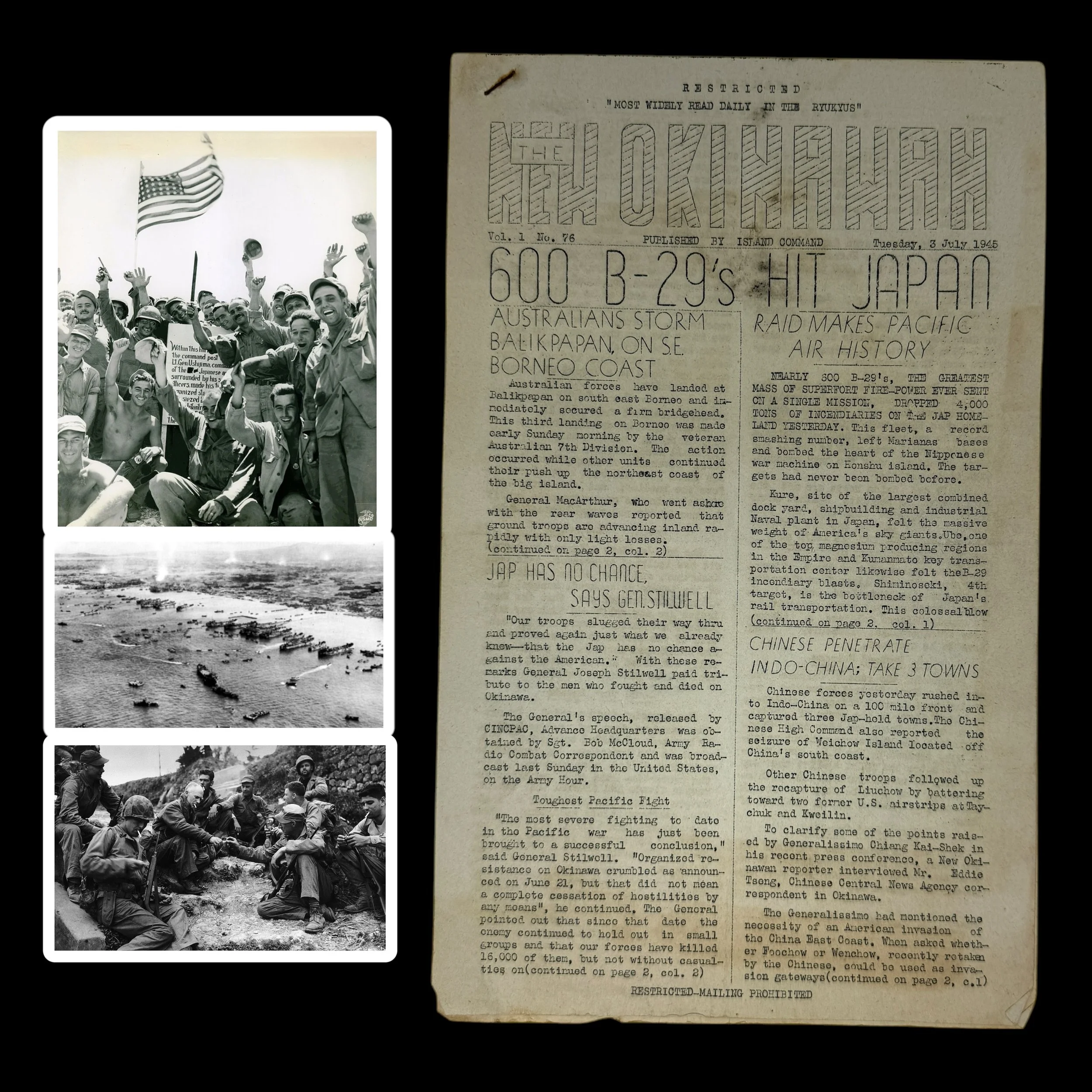
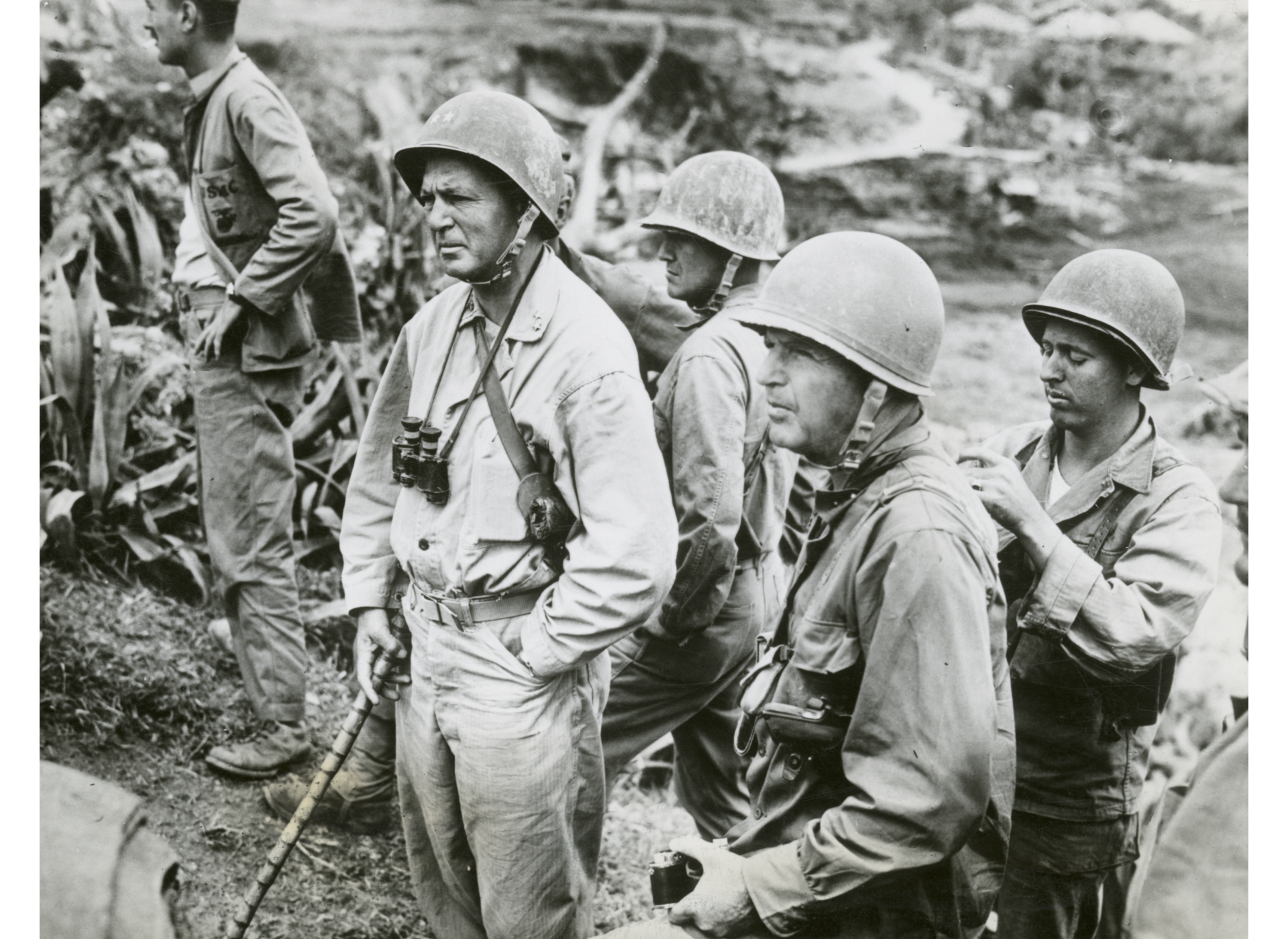
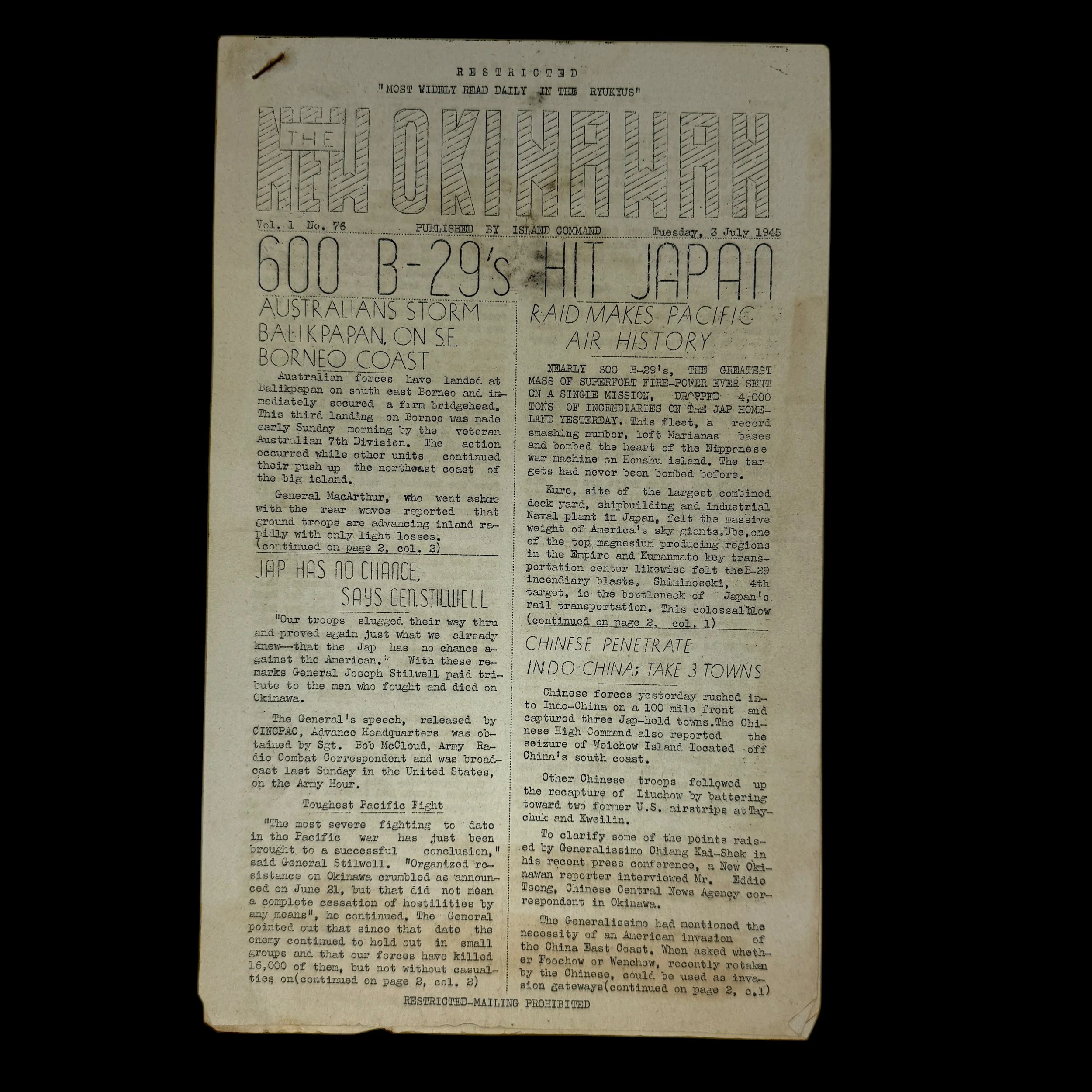
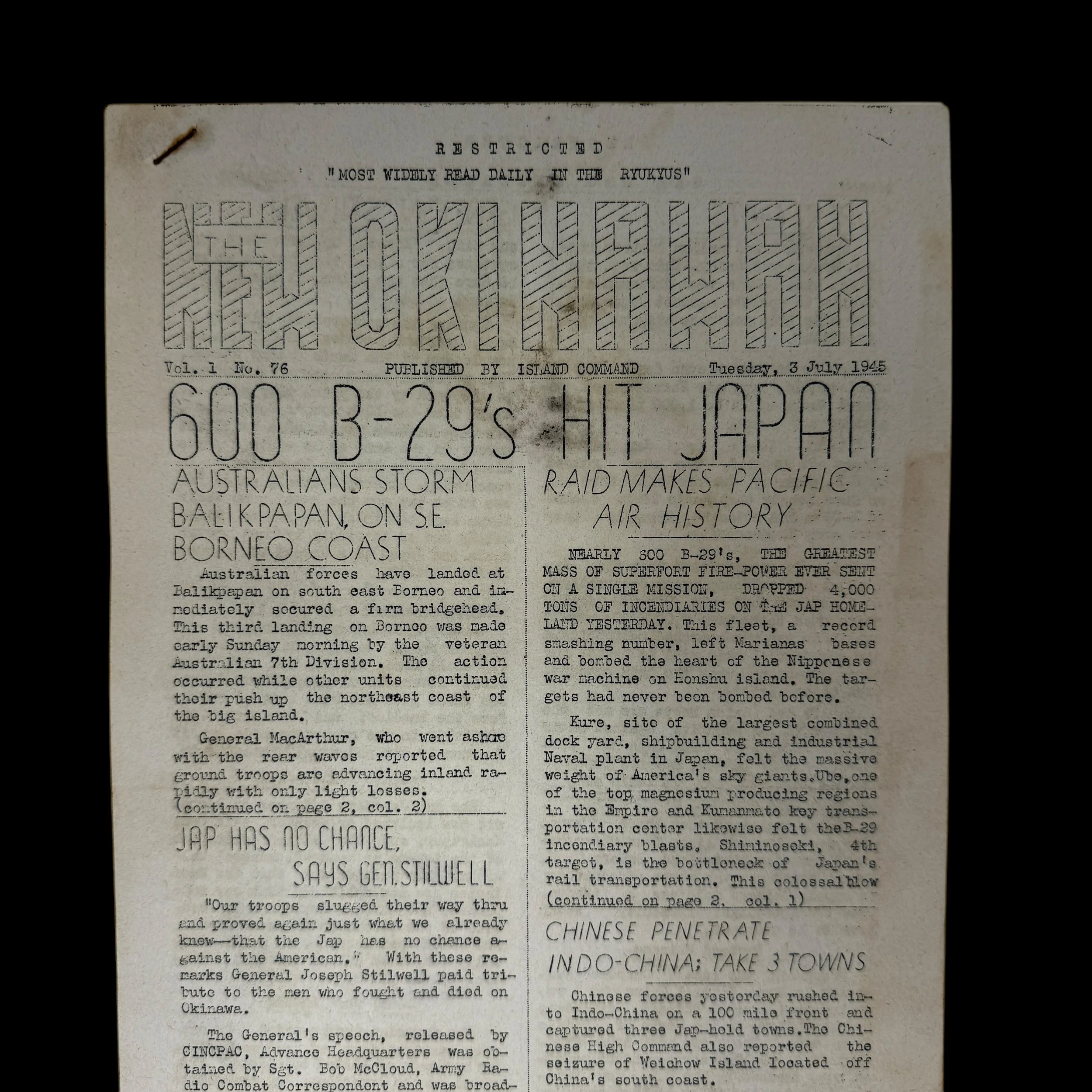
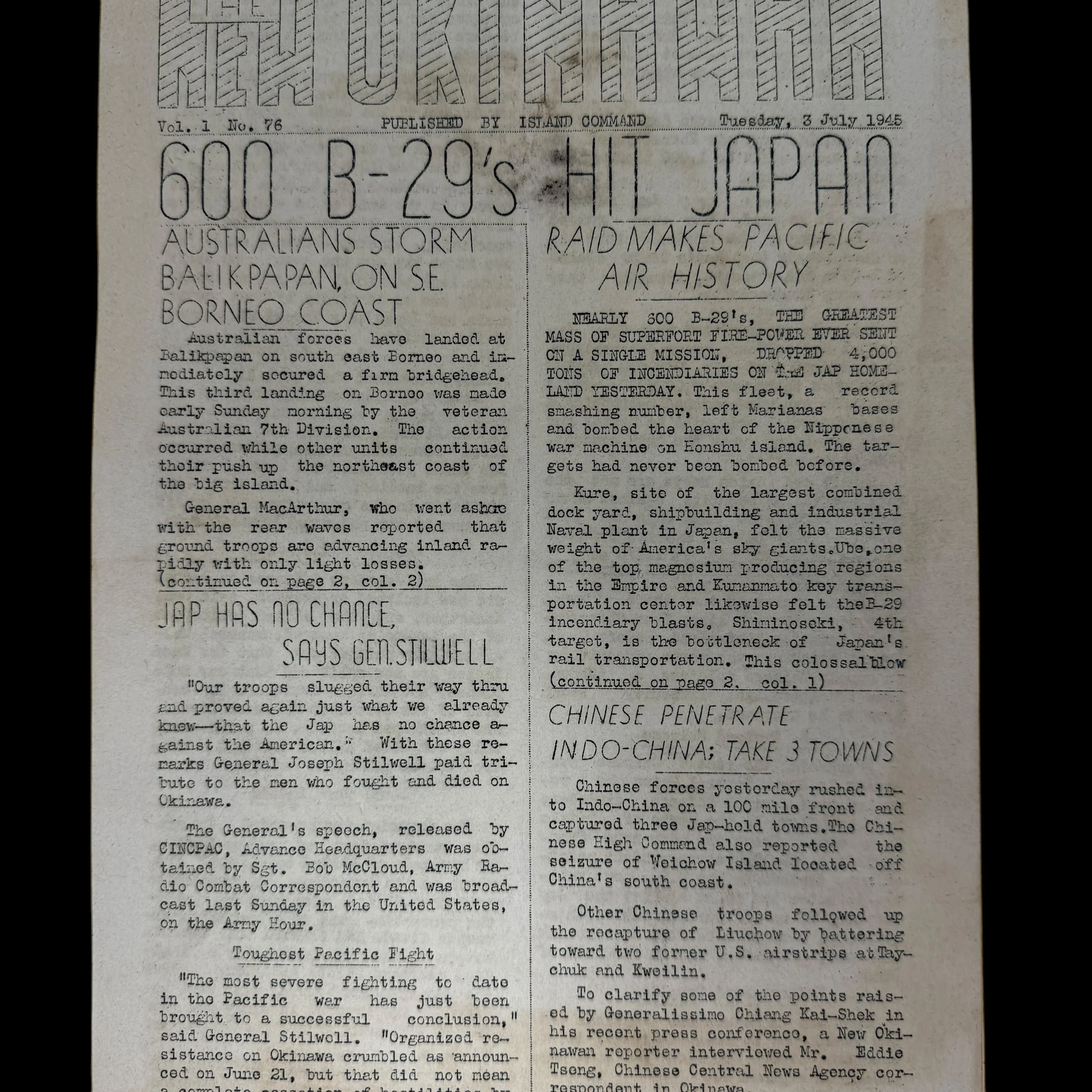
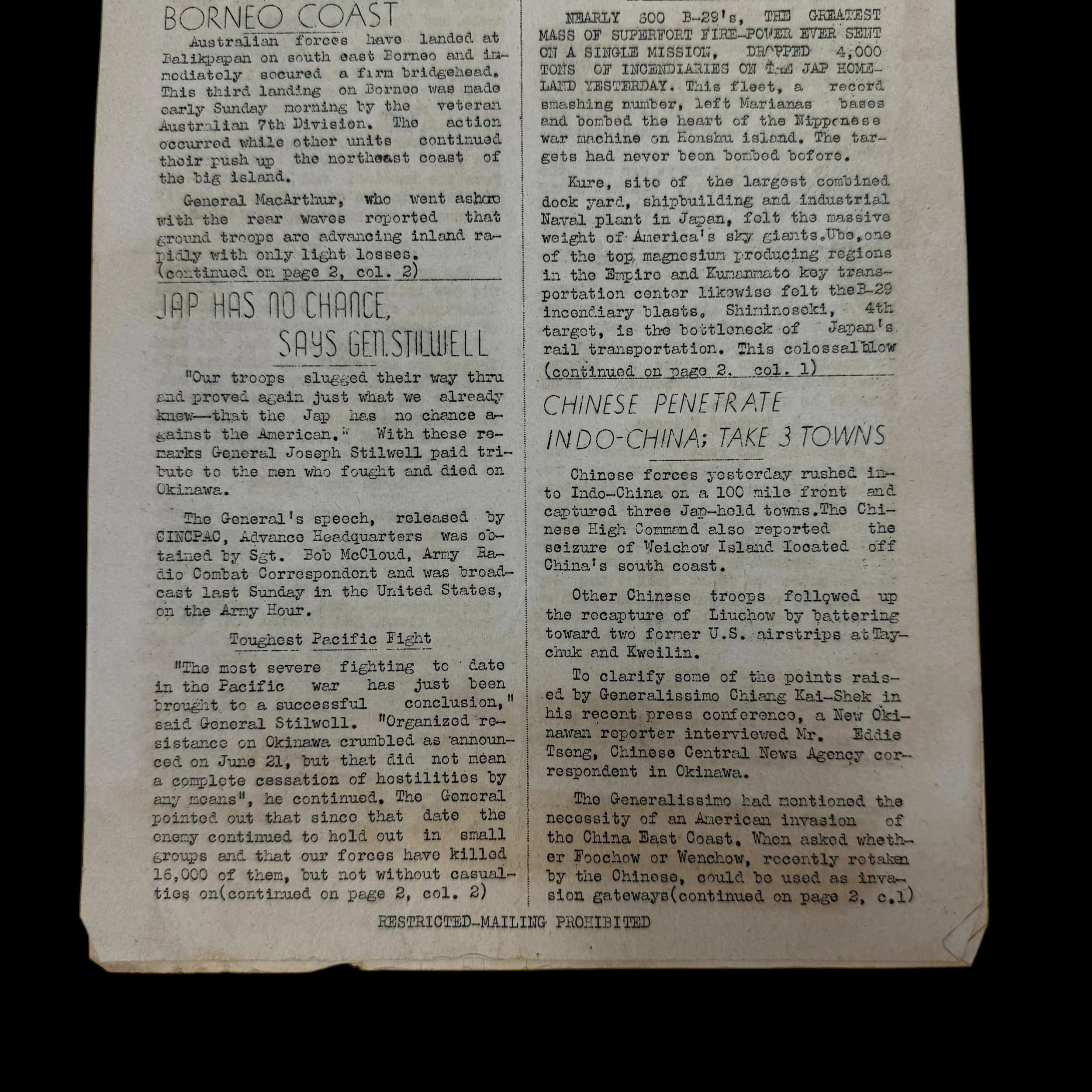
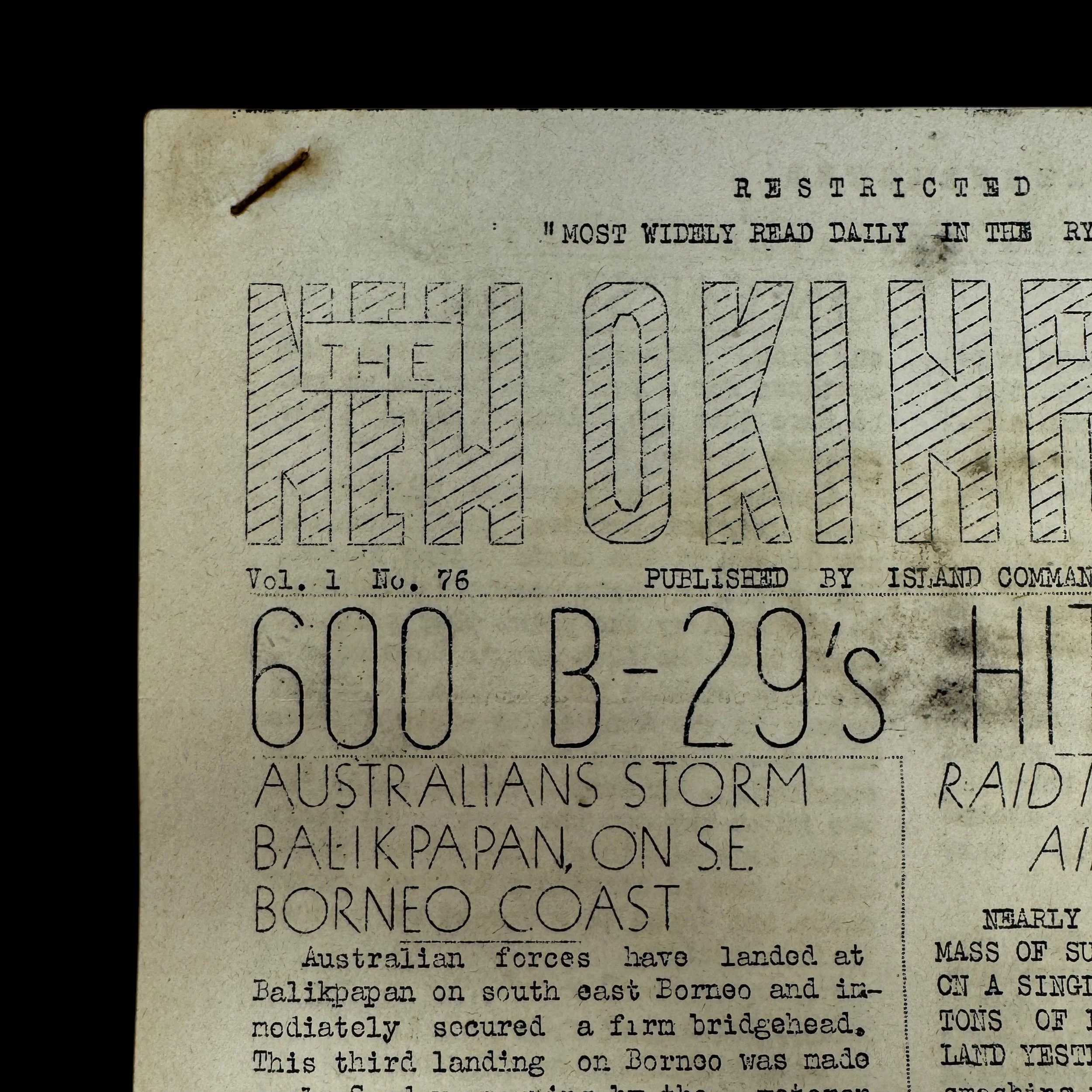
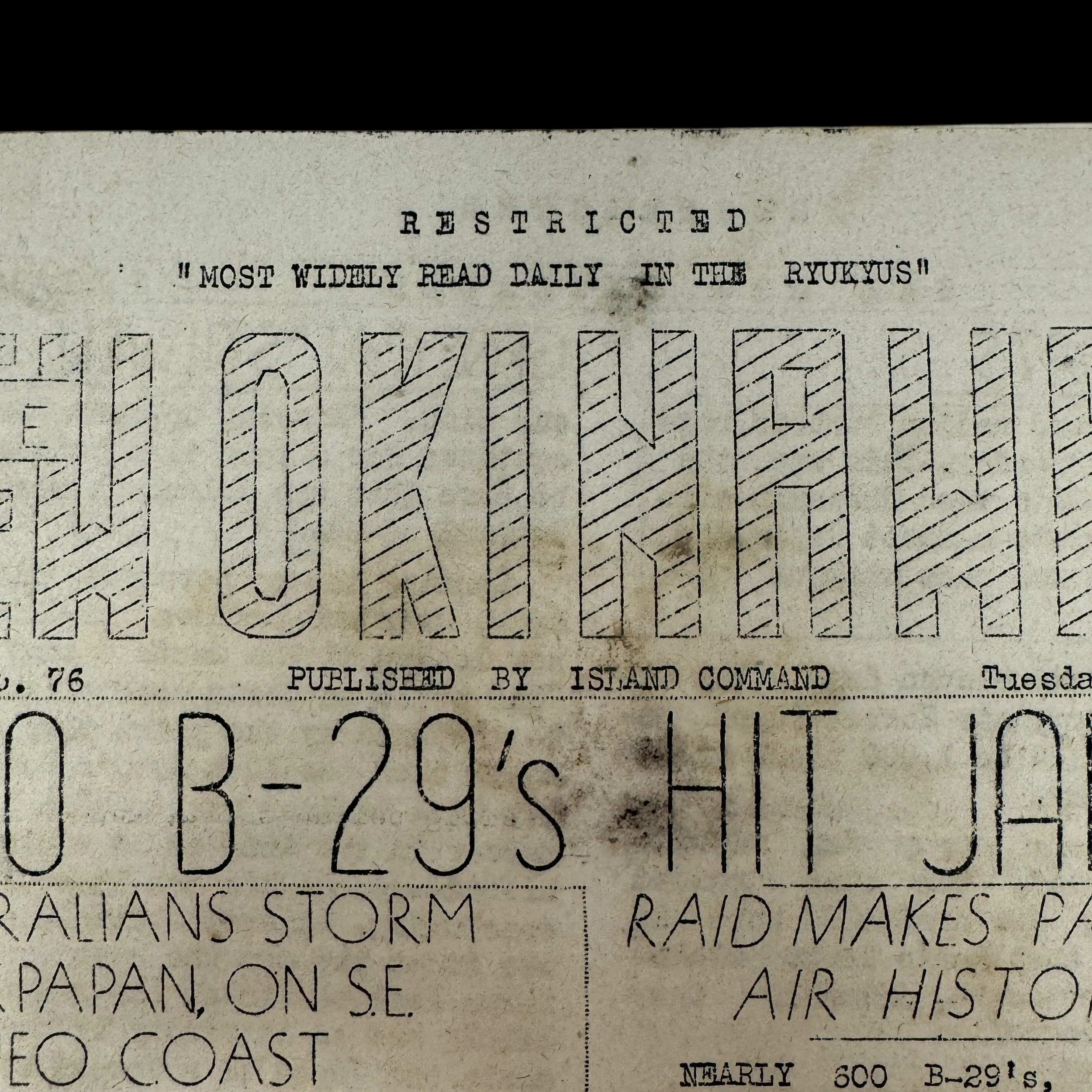
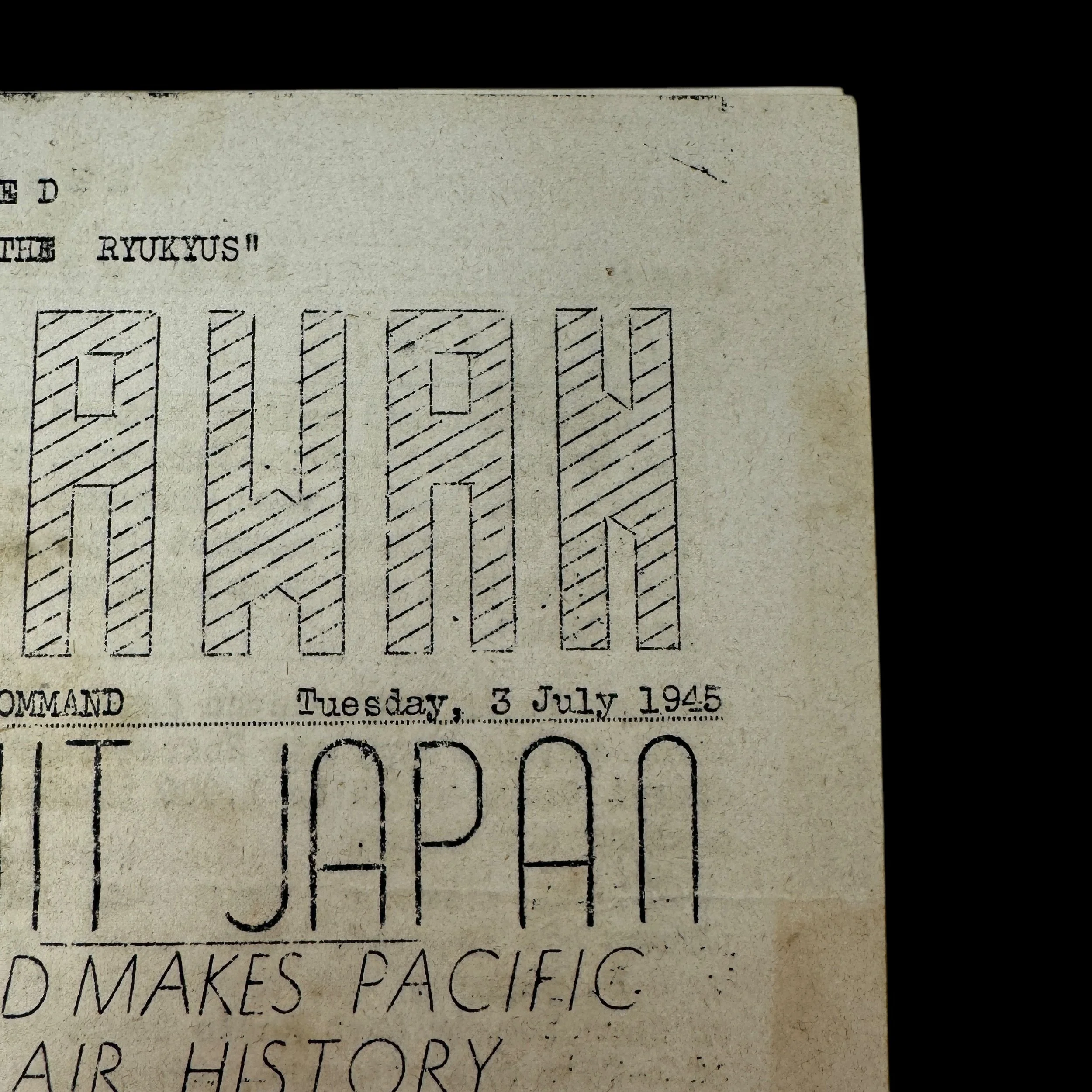
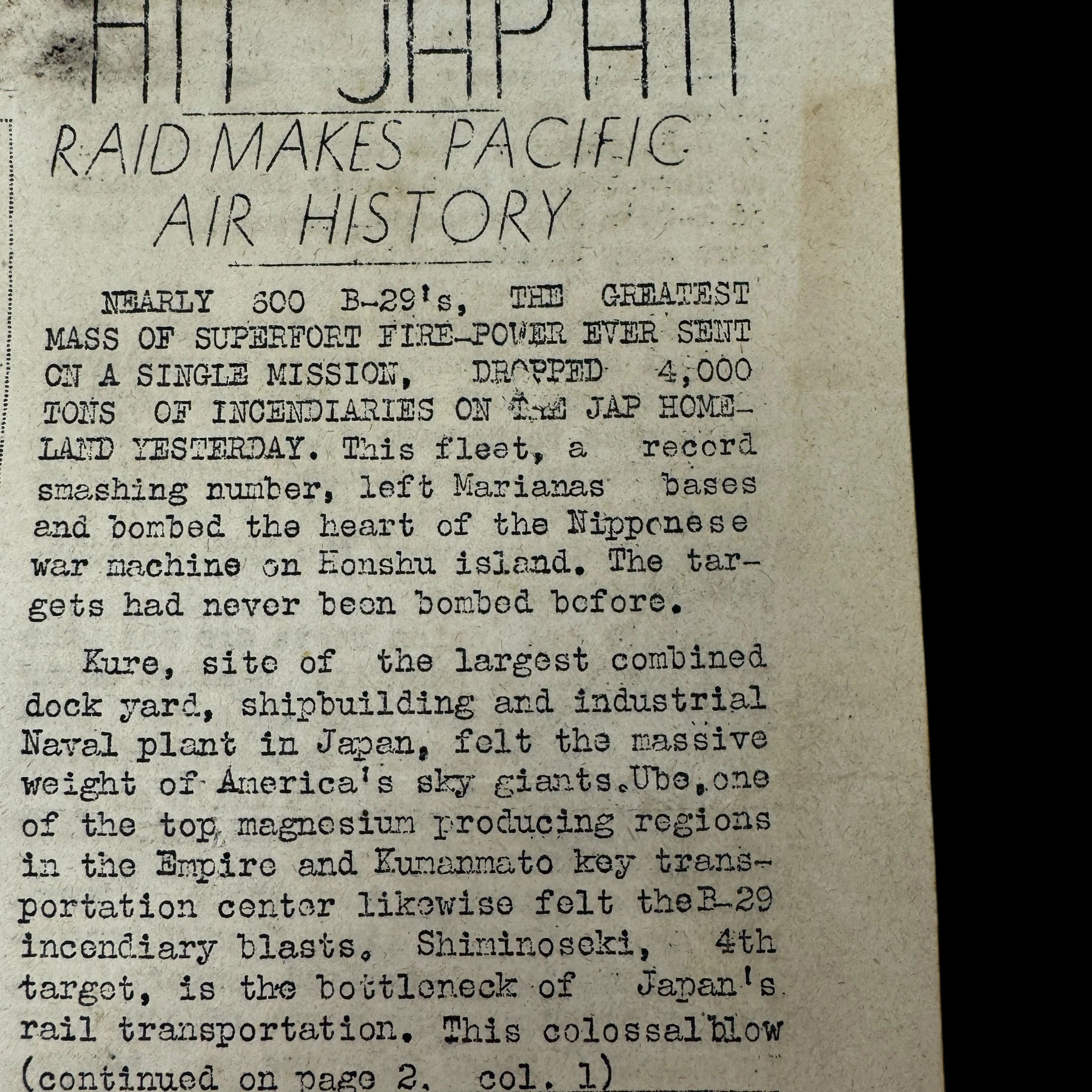
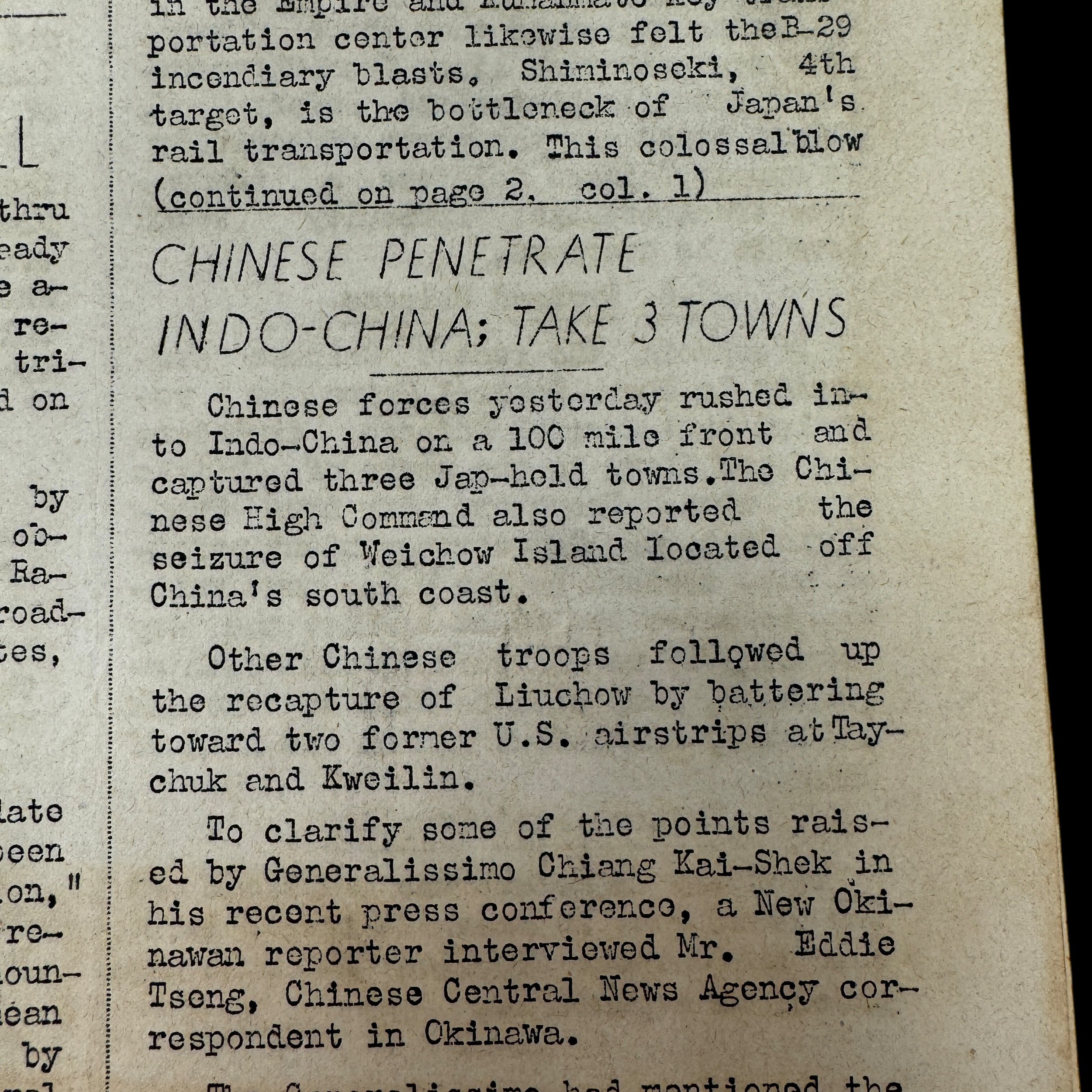
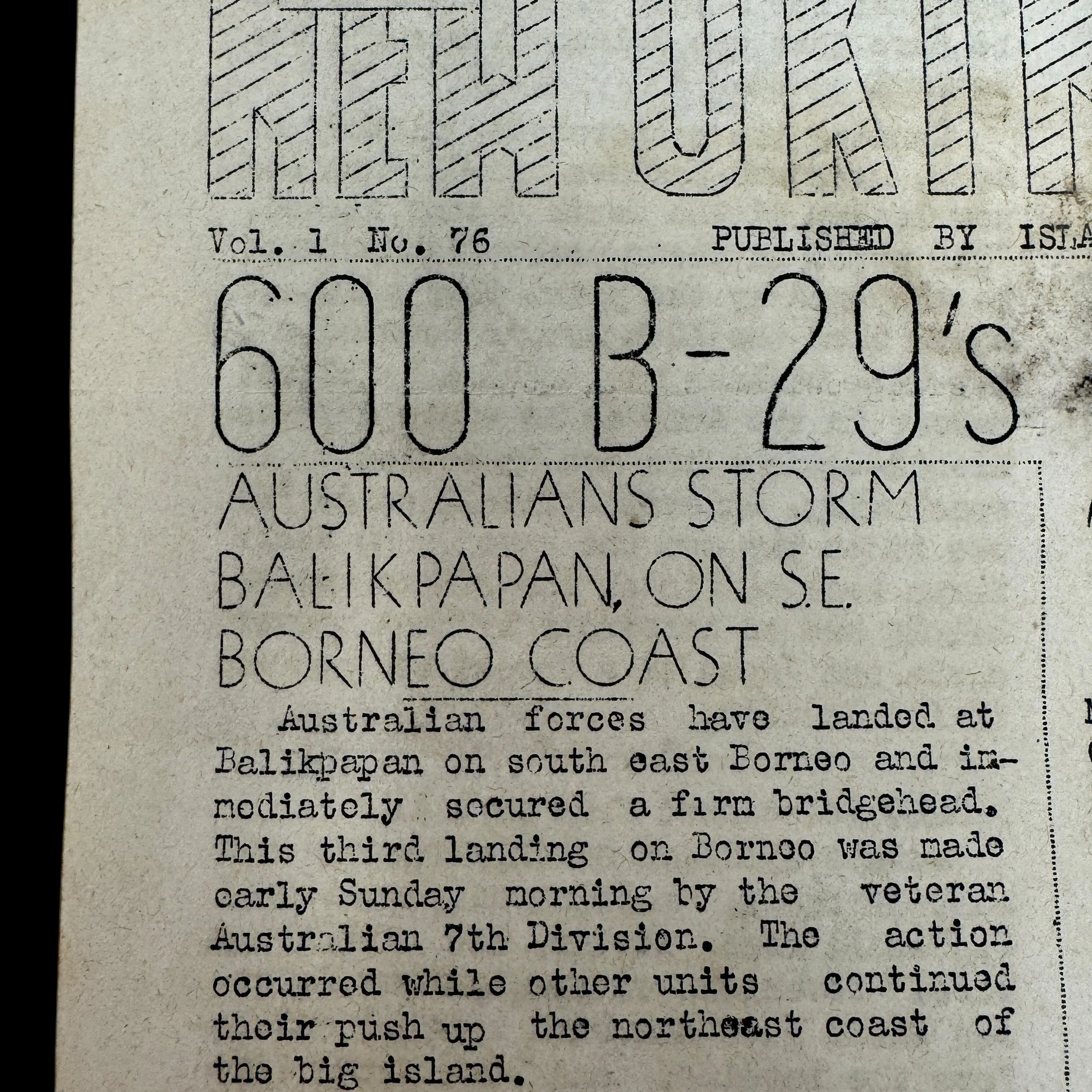
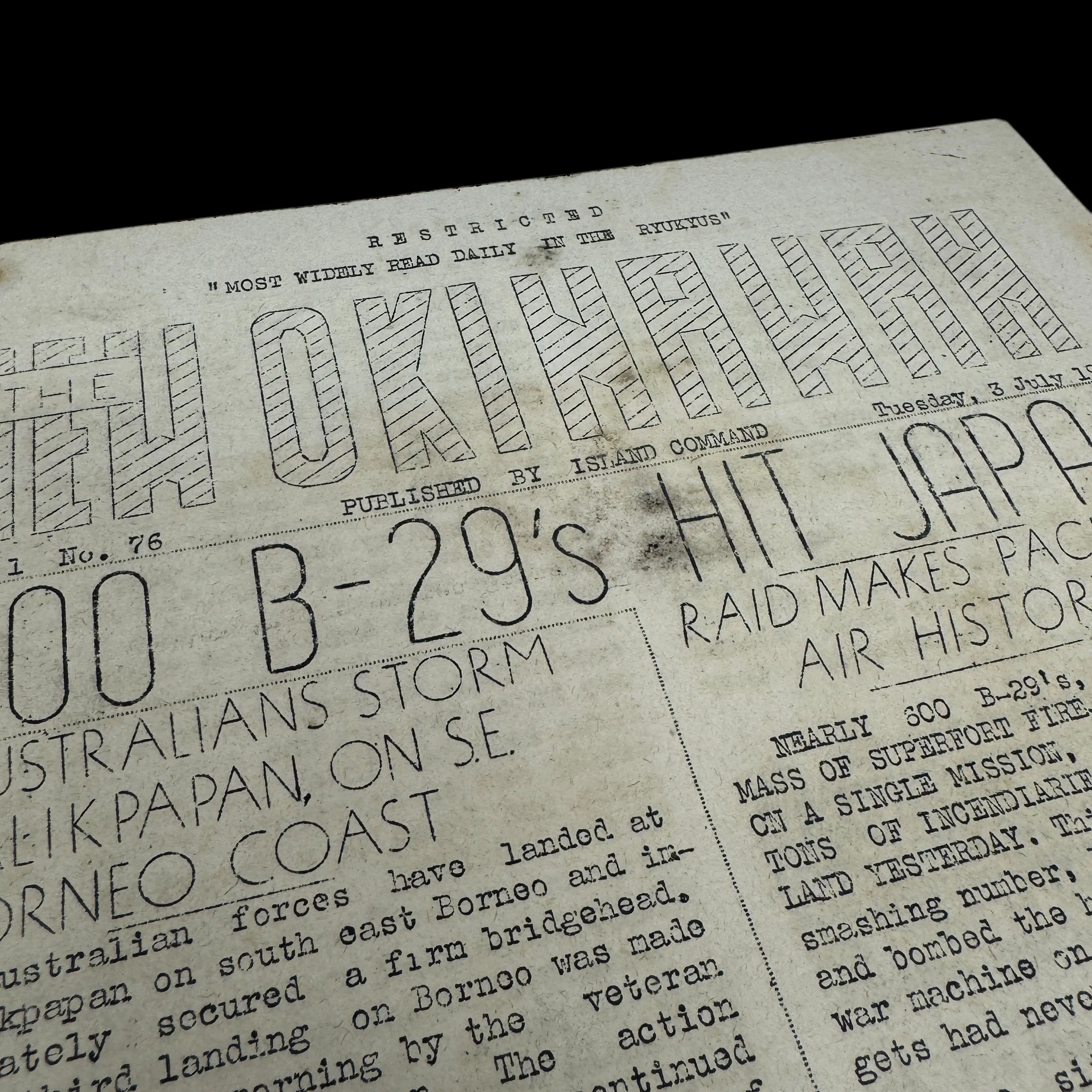
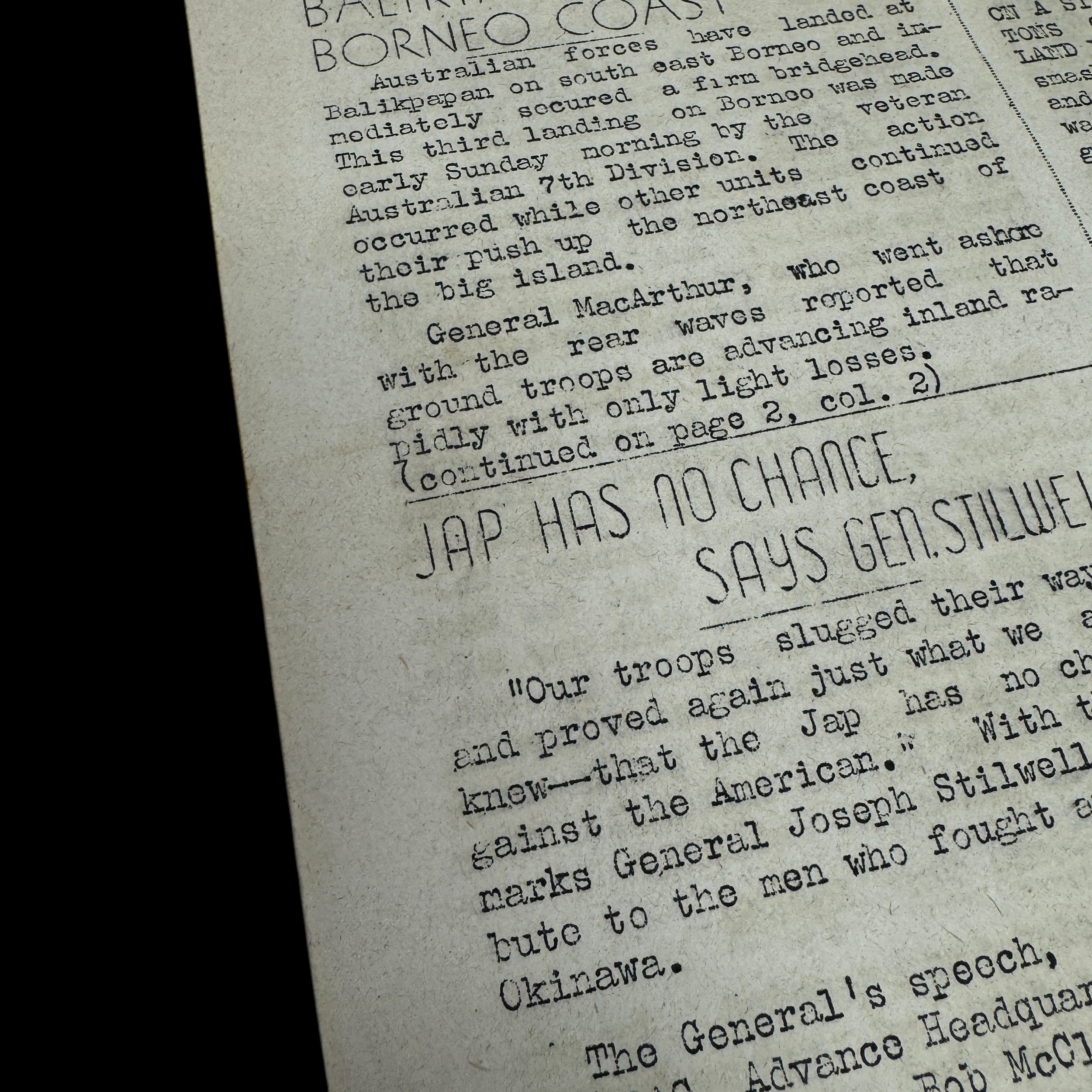
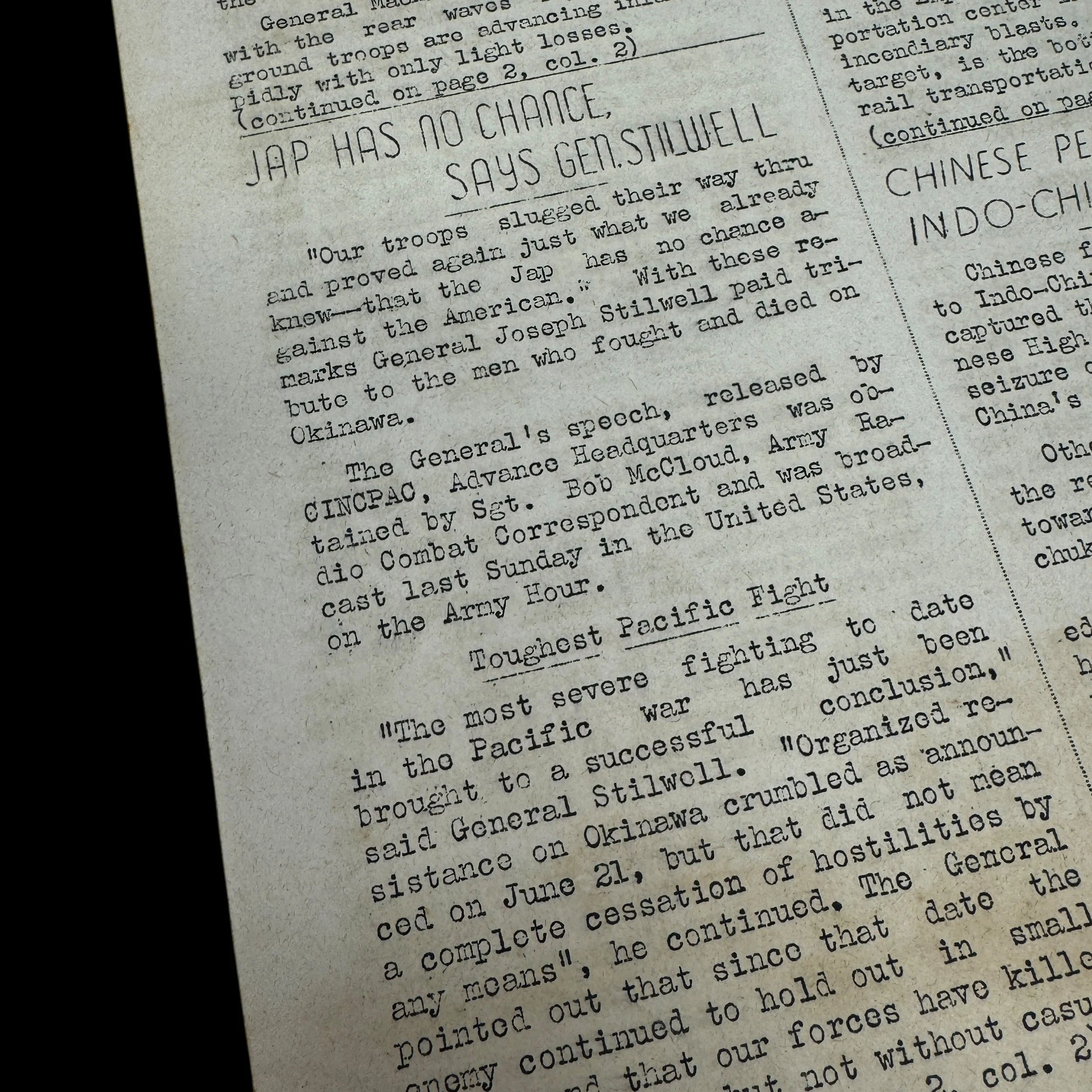

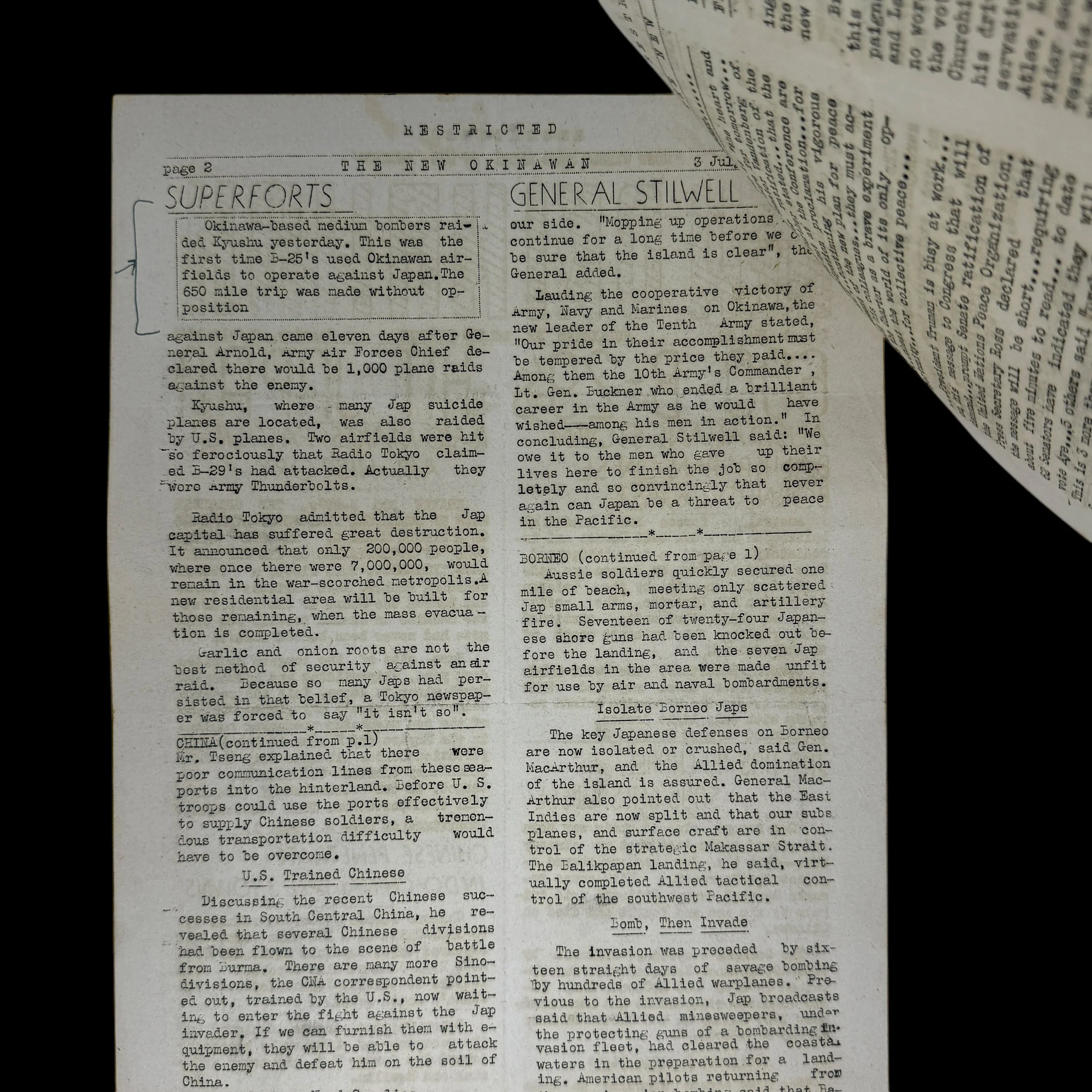
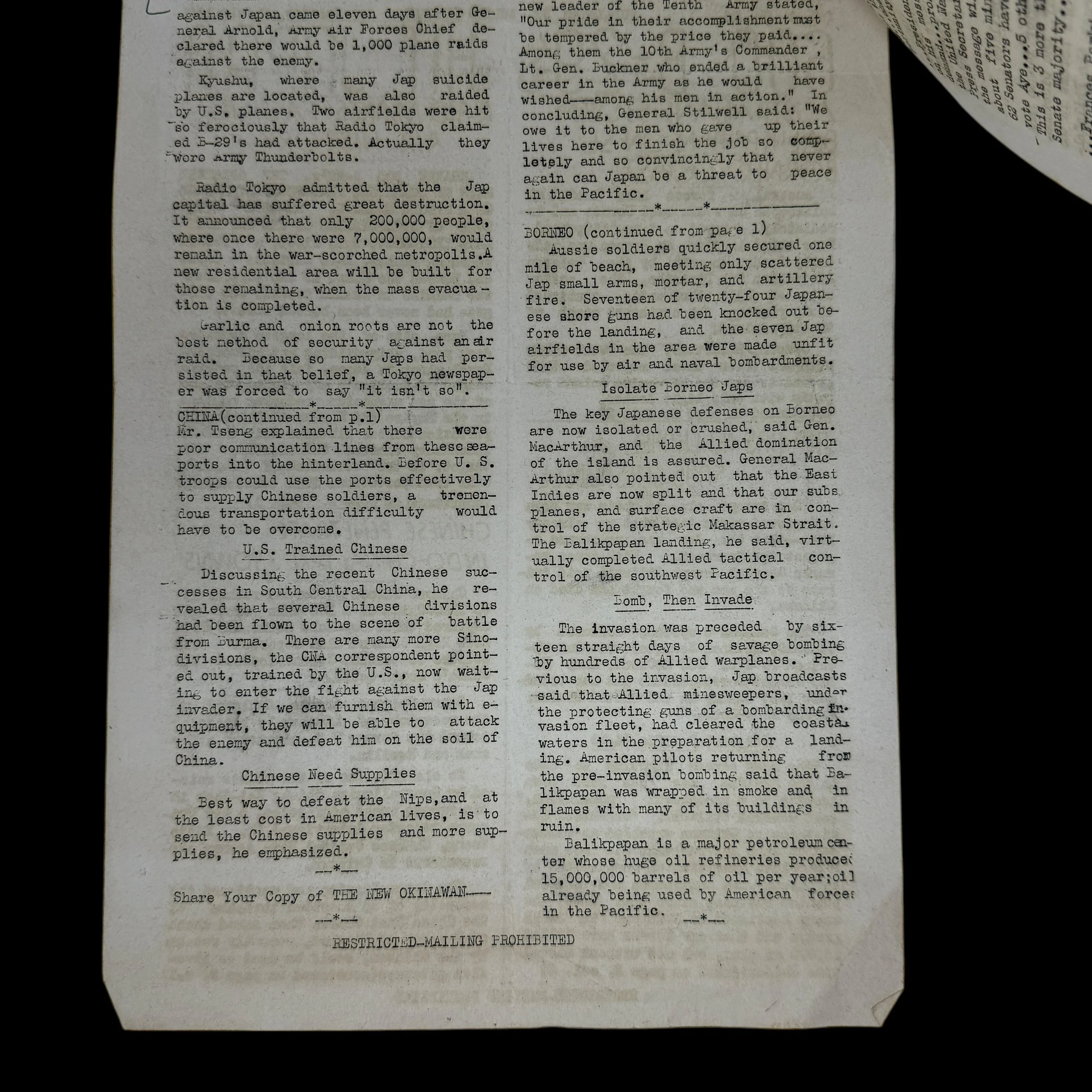
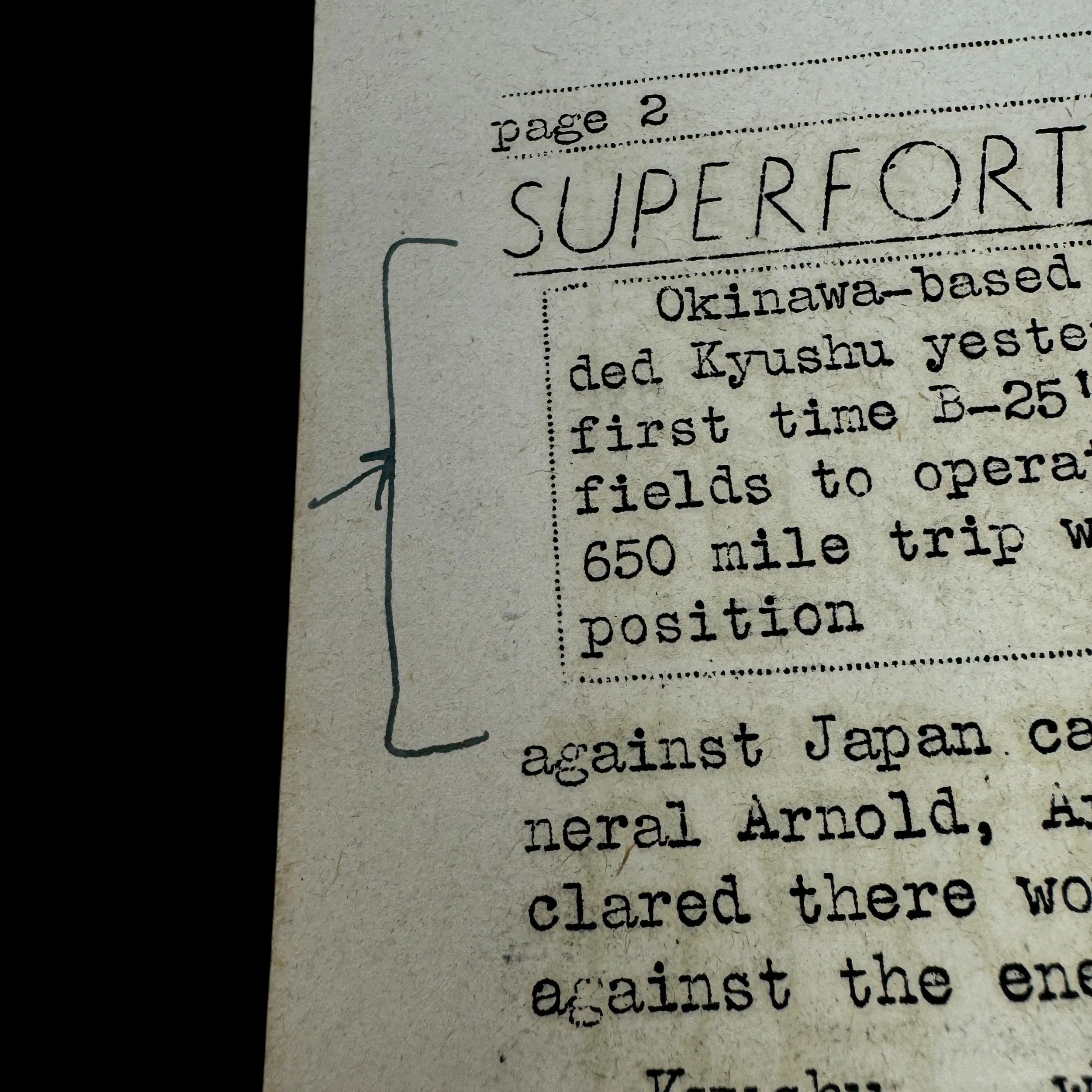
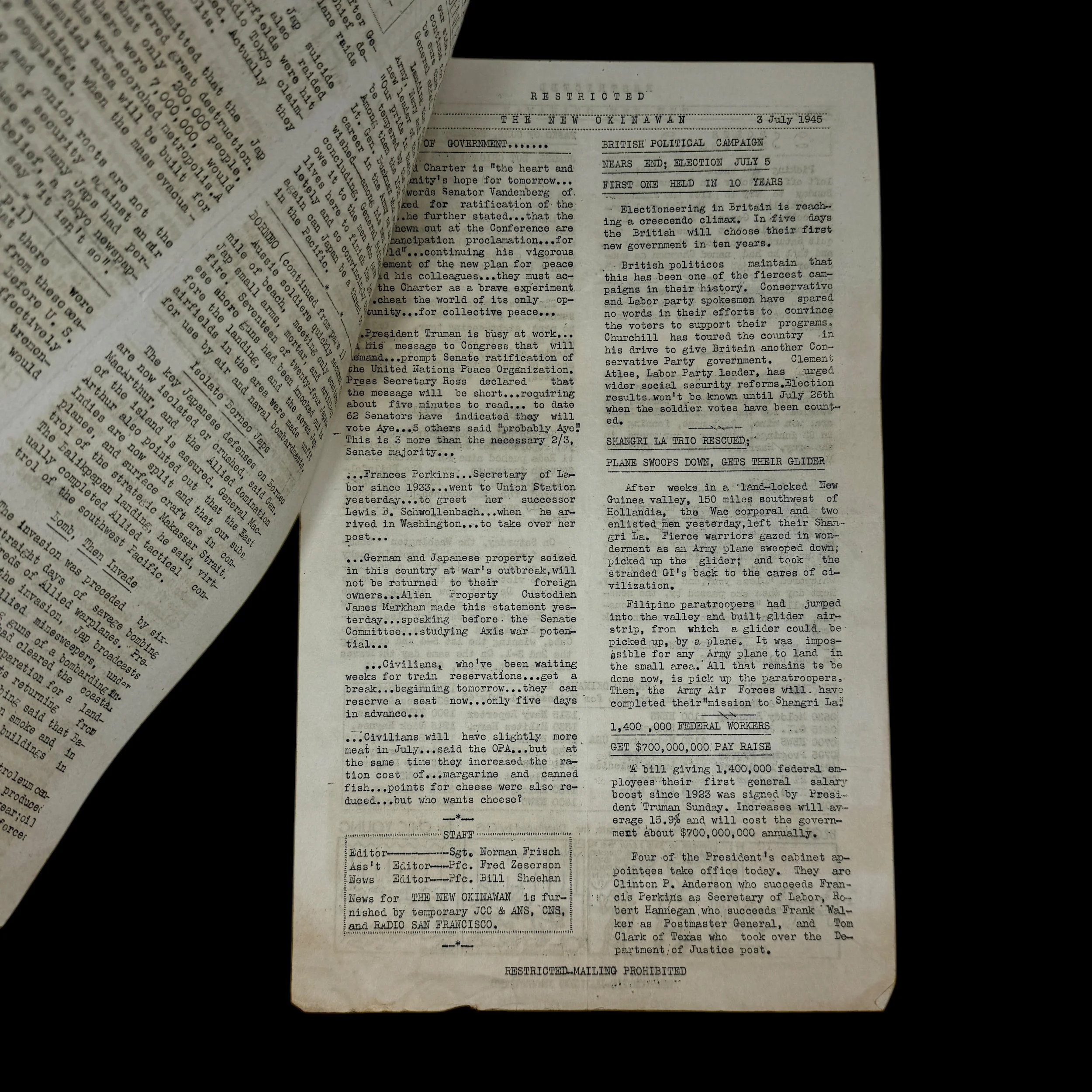
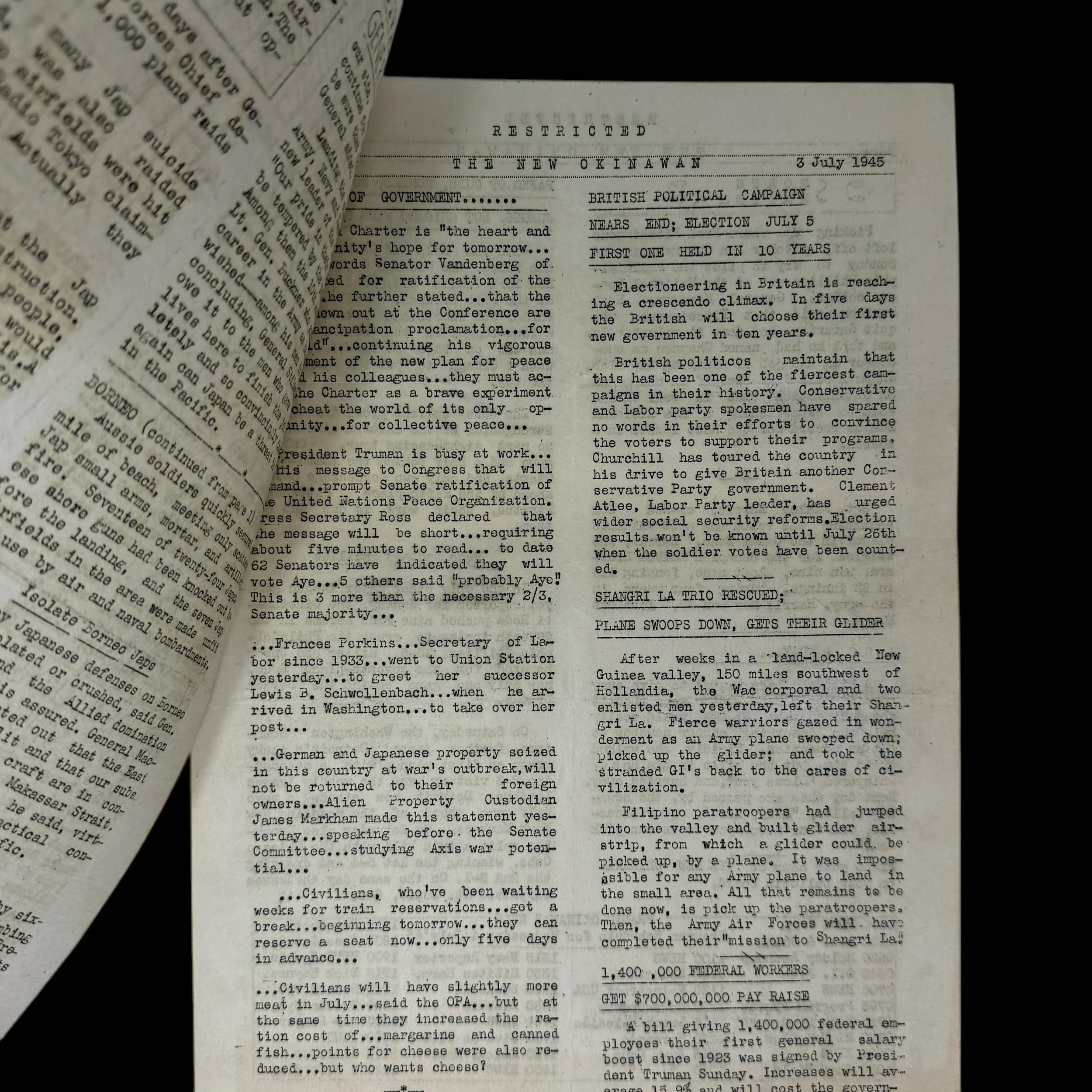

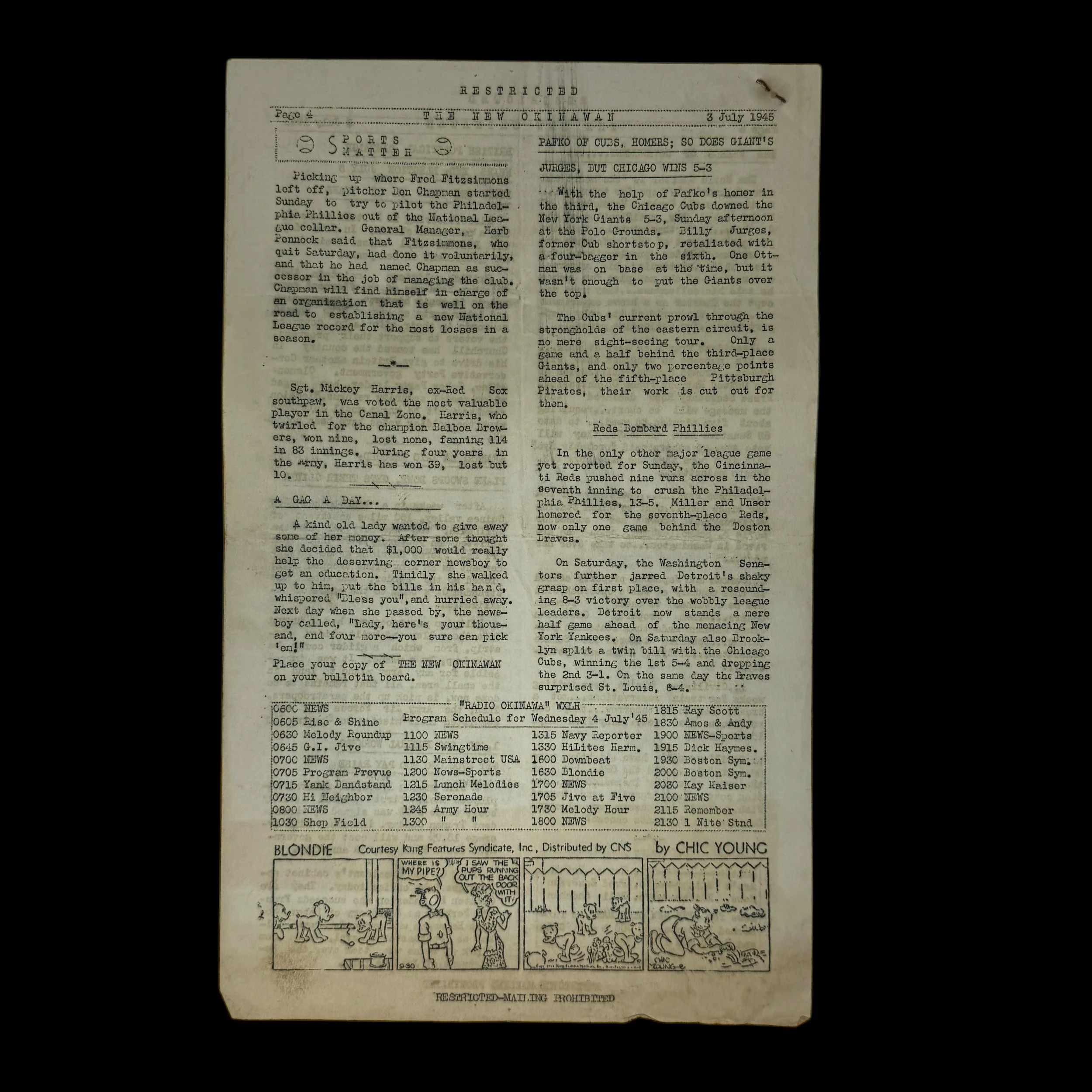

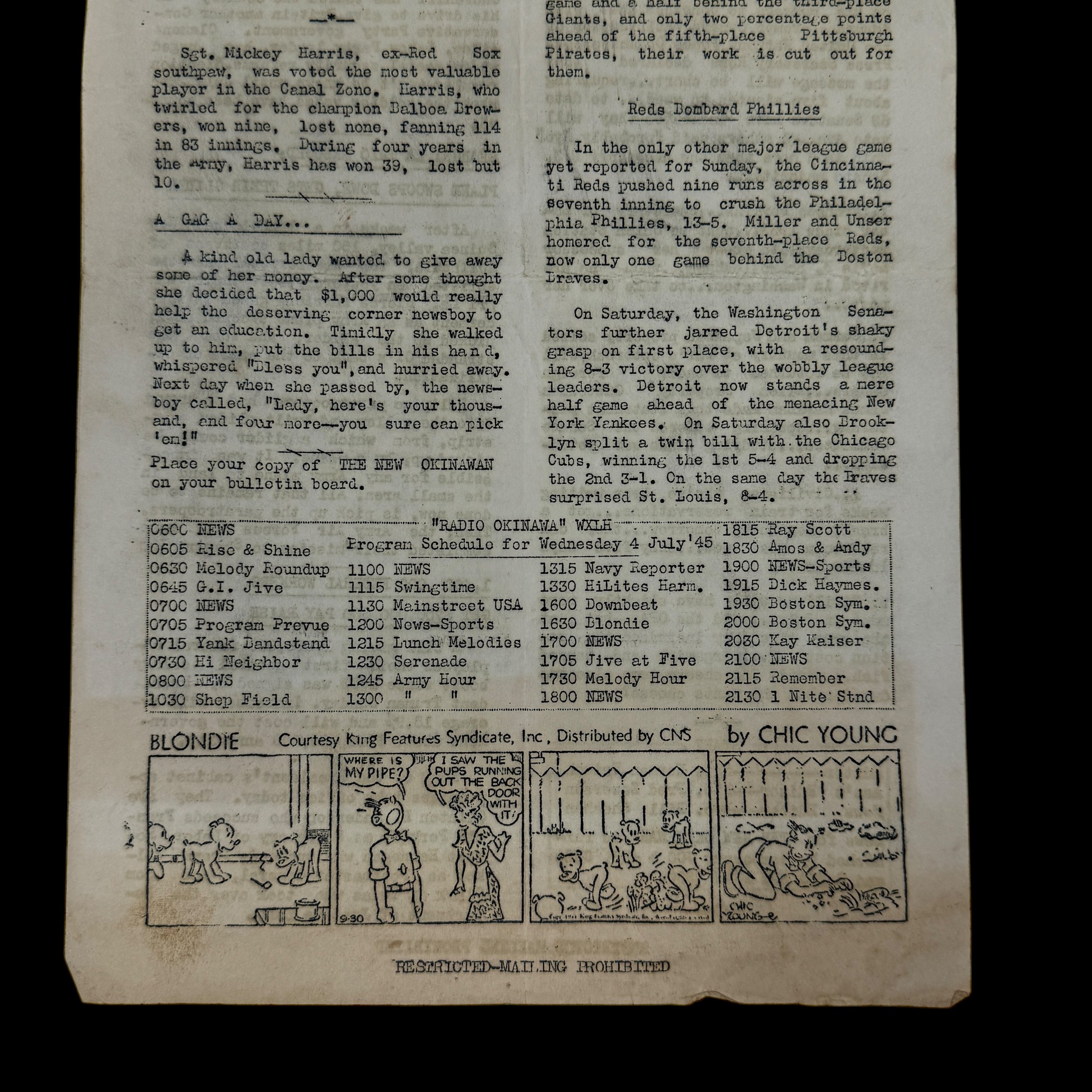
RARE! WWII July 3rd, 1945 "The New Okinawan" U.S. Soldier Produced Battlefield-Printed U.S. Military Combat Press Newspaper
Comes with a hand-signed C.O.A.
*Proudly deemed "OKINAWA’S FIRST & ONLY WWII U.S. SOLDIER PRODUCED MILITARY COMBAT NEWSPAPER” this 1945-dated The New Okinawan is considered a highly sought-after relic of both journalistic and World War II military history. Due to the harsh conditions under which this battlefield “field-printed” newspaper were printed on Okinawa, few copies survived the war. Those that remain are held by high-end museums archives.
Size: 8 x 13 inches
Details: This report details one of the largest B-29 Superfortress bombing missions of World War II—an unprecedented operation in which 600 B-29s launched from the Mariana Islands to strike targets on Honshu, the Japanese mainland. The issue also features General Joseph Stilwell’s powerful tribute to the soldiers who fought and fell during the brutal Battle of Okinawa. In a speech released by CINPAC, Stilwell described the campaign as the toughest fought in the entire Pacific Theater. Additionally, the newspaper reports on medium-range B-29 bombers based in Okinawa conducting a strategic raid on Kyushu, showcasing how newly secured Okinawan airfields were being used to extend U.S. reach into mainland Japan. The article also notes intercepted Tokyo radio transmissions following the attack, offering a rare glimpse into the immediate Japanese response.
This exceptionally rare, museum-grade WWII artifact is an original 1945 "The New Okinawan” battlefield-printed newspaper. Dated July 3rd, 1945, this unique soldier produced publication is a remarkable testament to the grit and resilience of the U.S. Army, Marines and military journalists stationed on Okinawa. It stands as a symbol of the determination to maintain communication and morale amidst one of the most brutal and pivotal battles of the Pacific Theater.
Publishing a newspaper in a battle zone was a near-impossible task. Equipment was scarce, paper supplies were limited, and the constant threat of enemy fire meant that the editorial team often had to move their operations to avoid danger. Yet, despite these overwhelming challenges, the dedicated soldiers, military journalists, and press corps on the island succeeded in producing The New Okinawan. This battlefield-printed newspaper was created, written, and distributed entirely on the island, making it an unprecedented and singular piece of WWII military press history.
While modest in appearance, the importance of The New Okinawan far exceeded its physical form. Produced on rudimentary printing presses, often under perilous conditions, the newspaper delivered vital news and updates to the soldiers stationed on the island. More than just a source of information, it became a lifeline, connecting the troops to the broader war effort and, crucially, to the world they had left behind. In an environment of chaos and uncertainty, the paper provided a sense of normalcy, giving the soldiers a brief respite from the horrors of battle while also keeping them updated on the war in the Pacific Theater.
In July of 1945, the Pacific Theater was at a pivotal and ferocious stage as the Allies closed in on Japan, with the Battle of Okinawa recently concluded but its aftermath still heavily influencing strategic decisions. The Battle of Okinawa, which officially ended on June 22, 1945, had been one of the bloodiest campaigns of the Pacific War, resulting in over 12,000 American deaths and more than 100,000 Japanese soldiers and an estimated 100,000 civilians killed. In the immediate weeks that followed, U.S. forces began securing the island and transforming it into a forward base of operations for a potential invasion of the Japanese home islands—an operation known as Operation Downfall. Engineers rapidly constructed airfields and supply depots, while medical units tended to the thousands of wounded and sick soldiers suffering from combat fatigue, disease, and injury. Meanwhile, in the broader Pacific Theater, the U.S. Navy’s Third Fleet, under Admiral William "Bull" Halsey, carried out aggressive air raids on the Japanese mainland, including bombings of Tokyo, as a part of a sustained campaign to weaken Japan’s industrial capacity and morale. The B-29 Superfortress bombers from bases in the Marianas continued their relentless firebombing of Japanese cities, causing catastrophic damage and civilian casualties. At the same time, political and military leaders in Washington and Tokyo weighed their options: the Allies issued the Potsdam Declaration on July 26, calling for Japan's unconditional surrender and warning of "prompt and utter destruction" if they refused—though the atomic bomb was not explicitly mentioned. The Japanese government, divided between hardliners who insisted on fighting to the bitter end and those quietly exploring surrender terms, hesitated to respond. All the while, the United States prepared for an invasion that could cost hundreds of thousands of lives, while in utmost secrecy, the Manhattan Project neared its culmination, having successfully tested the first atomic bomb at the Trinity site in New Mexico just days earlier, on July 16. The stage was set for a final, devastating chapter in the Pacific War.
The Battle of Okinawa, fought from April 1 to June 22, 1945, was the largest and bloodiest battle in the Pacific Theater of World War II. As the final major battle before a planned invasion of the Japanese home islands, Okinawa held immense strategic importance. U.S. Army and Marine Corps forces faced fierce resistance from deeply entrenched Japanese defenders, including fanatical kamikaze attacks targeting the U.S. Navy. The battle unfolded across rugged terrain, caves, and ridgelines, resulting in prolonged and brutal combat. American forces suffered over 49,000 casualties, including more than 12,000 killed, while Japanese military losses were even higher—alongside a devastating toll on Okinawan civilians. The ferocity and scale of the fighting shocked American planners and influenced the decision to use atomic weapons rather than invade Japan directly. In the aftermath, Okinawa became a critical staging area for Allied forces, and its capture effectively sealed Japan’s isolation, setting the stage for the final chapters of World War II.
Despite the cessation of active combat on the island, life on Okinawa after the battle was far from peaceful. The island remained a critical airbase, where U.S. forces continued operations until Japan’s surrender in September 1945. Soldiers stationed on Okinawa faced isolation, the ongoing threat of booby traps left by Japanese forces, and the psychological toll of having fought in one of the war’s bloodiest battles. Amid this atmosphere of uncertainty, the New Okinawan served as a vital outlet, providing news, updates, and, most importantly, a connection to the outside world.
The New Okinawan, though small and short-lived, was a symbol of resilience and hope for the soldiers who read it. The fact that it was printed at all, amidst the rubble of war, is a testament to the unyielding human spirit. The paper embodied the belief that even in the direst of circumstances, information and communication were essential for survival. It also underscored the military’s commitment to maintaining morale, even on the most remote and war-torn battlefields.
Today, the New Okinawan is considered a highly sought-after relic of both journalistic and military history. Due to the harsh conditions under which it was printed, few copies survived the war. Those that remain are held by museums, collectors, and archives as precious artifacts, offering a rare glimpse into the lives of the soldiers who fought on Okinawa. These newspapers are not only valuable for their historical context but also for the poignant story they tell—of soldiers seeking connection, comfort, and hope during one of the most harrowing experiences of World War II.
This original 1945 New Okinawan newspaper is a piece of history that continues to resonate, symbolizing the indomitable will of those who fought and served during the war. It stands as a rare, tangible link to the battlefield, a testament to the importance of communication, and a tribute to the extraordinary efforts of those who kept the spirit of humanity alive in the most difficult of times.